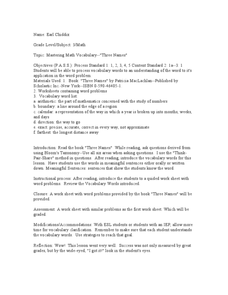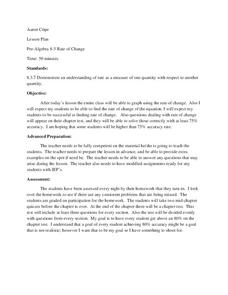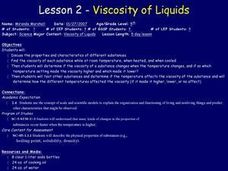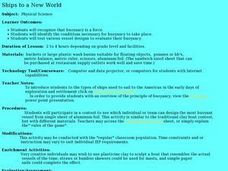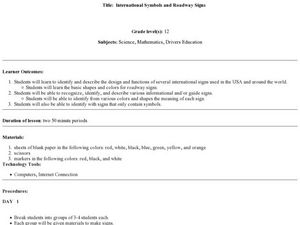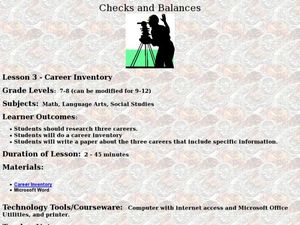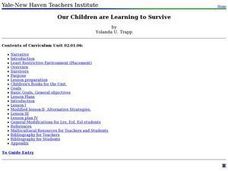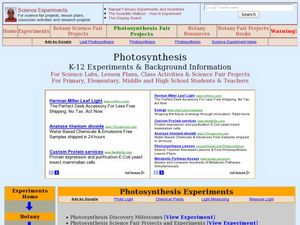Curated OER
Mastering Math Vocabulary- The Three Bears
Integrate reading and math to increase your class' vocabulary. Read The Three Bears by Paul Galdone. Then have your third graders complete a worksheet containing math problems related to the story.
Curated OER
three Names Lesson
After the book Three Names is read aloud, math vocabulary is introduced . Either alone or in groups, learners use the vocabulary words in a meaningful sentence. Then they complete the provided worksheet.
Curated OER
Brog-Cube-the Spam
A Middle school special ed class uses the acronym SPAM to learn the 4 parts of writing. They employ 4 different colors to help them visually distinguish each part of writing in a given prompt. This lesson is vague and uses a strong...
Curated OER
21st Century Social Skills
Explore communication techniques by using the latest video technology. In this special education lesson, students create a video discussing their own social goals for the future. Students utilize Flip Video cameras to...
Curated OER
Rate of Change
Eleventh graders solve problems dealing with rate of change. In this algebra instructional activity, 11th graders graph their rate of change problems and analyze it comparing their data with each other. They solve problems dealing with...
Curated OER
What's the Earth Worth?
Students are able to identify natural resources from a shared reading by highlighting, scoring at least a 3 on a 4 point rubic. They describe in journal entries, after reading the book Amelia Bedelia Goes Camping or Curious Geogre Goes...
Curated OER
Plants, Animals and Our Environment
Students draw and label the basic needs of animals. They draw and label the basic needs of plants. Students understand the basic needs of plants and animals are not only the same, but are interrelated. They know that the environment...
Curated OER
Brick Memorial Flyer
Students conduct research using the internet, school server and newspapers on the history of the brick memorial for veterans and its developmental process. They create and design a three column page layout for a brochure using Microsoft...
Curated OER
States of Matter
Fourth graders define the term matter. They compare properties of solids, liquids, and gases. They describe how matter changes from one state to another. They classify objects as either solid, liquid, or gas.
Curated OER
Viscosity of Liquids
Fifth graders discuss the properties and characteristics of different substances. They find the viscosity of each substance while at room temperature, when heated and when cooled. They determine if the viscosity of a substance changes...
Curated OER
What is a Seed?
First graders identify the parts of a seed. In this plant biology instructional activity, 1st graders are given a seed and identify each part of the seed by using a hand lens. Students plant a seed and graph the growth.
Curated OER
There's No Accountin with Ledgers
Tenth graders create and maintain a ledger, write an essay for the process, and learn to keep financial accounts through the ledger. In this ledger instructional activity, 10th graders define an accounting ledger and create one for the...
Curated OER
Egg to Butterfly
Students examine the life cycle of the butterfly through literature. In this butterfly life cycle instructional activity, students listen to a read aloud of Eric Carle's, The Very Hungry Caterpillar, and discuss the life cycle shown in...
Curated OER
Nutrients
Fourth graders understand the important nutrients in food and the value of each. In this nutrients lesson, 4th graders complete a chart giving examples of foods that contain that nutrient and a definition of the nutrient. Students...
Curated OER
Bird and Breakfast
Students examine winter birds. In this KWL chart lesson, students fill out the chart and view a PowerPoint presentation. Students then complete the chart and discuss winter birds.
Curated OER
Ships to a New World
Young scholars experiment with buoyancy as a force. In this buoyancy lesson plan, students access an assigned website to examine the sailing vessels that came to the New World. They work as teams to build boats out of aluminum foil to...
Curated OER
The French Revolution
Tenth graders explore the events leading up to the French Revolution. In this World History instructional activity, 10th graders participate in a class discussion as the teacher shares a Powerpoint presentation, then the students...
Curated OER
International Symbols and Roadway Signs
Students explore the function of various road signs and international symbols. In this sign recognition lesson, students construct road signs with blank paper, markers, and scissors. Students make 2 or 3 different signs and...
Curated OER
You Can Stop!!
Students analyze smoking behavior based on peer pressure. In this health lesson, students read and complete worksheets on the internet concerning the behaviors associated with smoking. They summarize what they have learned by...
Curated OER
Career Inventory
Students research three careers and write an essay in which they give specific information about each. In this career lesson, students use career finder to discover information about three careers. Students will discuss each career in an...
Curated OER
Imagination Express: Rain Forest
Fourth graders use spoken, written, and visual language to communicate effectively with a variety of audiences. He also demonstrate a knowledge of the rainforest.
Curated OER
Our Children are Learning to Survive
Students examine the various cultures of the world through literature. After reading various stories, they compare their own personal experience with the characters. In groups, they take the original story and add their own characters...
Curated OER
Literal Equations
Students explore Literal Equations. In this literal equations lesson plan, students use the Internet to connect to links and solve linear equations. Students investigate, analyze and record their findings on various activity worksheets.
Curated OER
Photosynthesis
Students explore the concept of photosynthesis. They describe the light and light independent reactions of photosynthesis. Students relate physical plant characteristics to their functions. They distinguish between C3, C4, and CAM plants...

